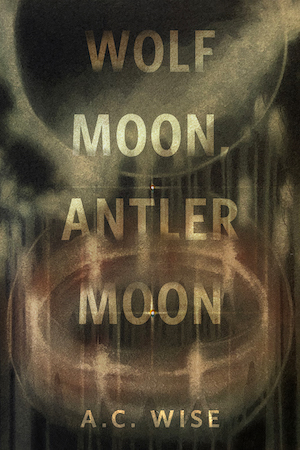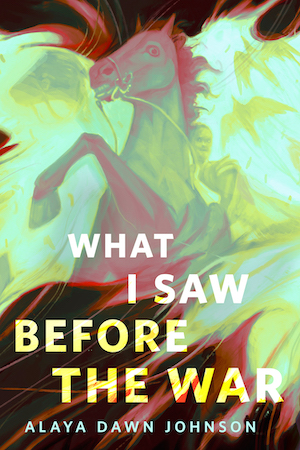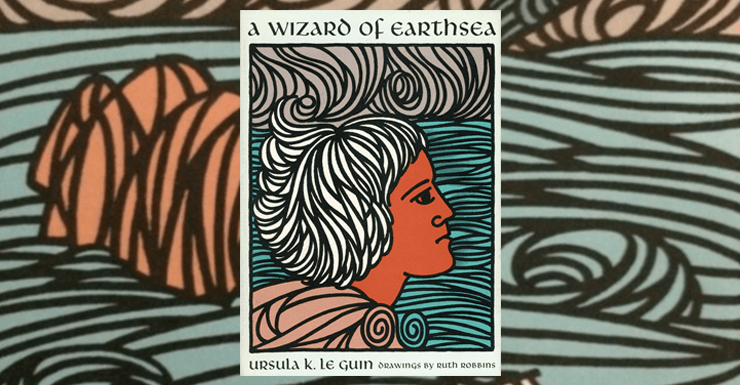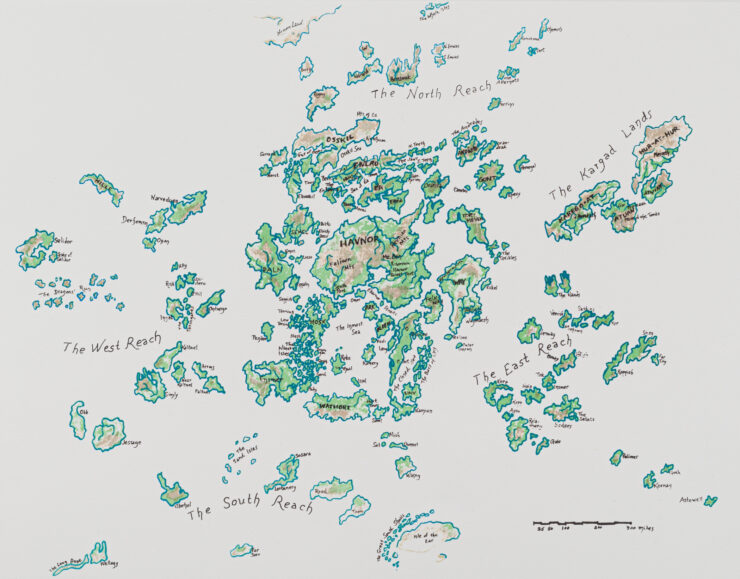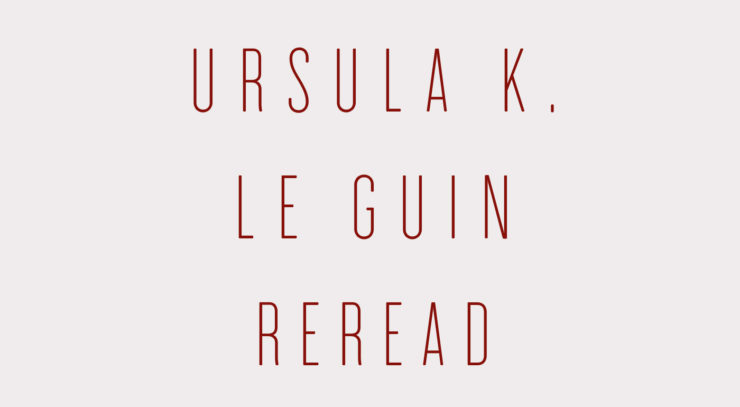This week, Saga Press releases a gorgeous new omnibus edition of Ursula K. Le Guin’s Books of Earthsea, illustrated by Charles Vess, in celebration of A Wizard of Earthsea‘s 50th anniversary. In honor of that anniversary, this week we’re running a different look at Earthsea each day—starting with the first book in the series.
“A great many white readers in 1967 were not ready to accept a brown-skinned hero,” Ursula Le Guin wrote in 2012 in an afterword to A Wizard of Earthsea, forty-four years after the seminal novel—the first in the Earthsea cycle—was published. “But they weren’t expecting one,” she continued. “I didn’t make an issue of it, and you have to be well into the book before you realize that Ged, like most of the characters, isn’t white.”
That Ged, the novel’s protagonist, was nonwhite did, however, create consternation for the book’s cover, as Le Guin noted in her afterword. It was one thing to write a brown character; it was another to have the audacity to request one appear on the cover. Perhaps out of the fear that seeing a brown figure would deter readers—African-American sci-fi writers were similarly told, for decades, that there was no market for their work, as black people, their publishers presumed, did not read sci-fi, and white readers might similarly be turned off—Ged was repeatedly depicted as “lily-white” on many of the book’s covers. To Le Guin’s joyous relief, the book’s original cover features an illustration by Ruth Robbins, in which Ged, faintly resembling a figure from either a medieval painting or Art Deco, has a soft “copper-brown” complexion. It was “the book’s one true cover,” she said fondly.
A Wizard of Earthsea was riveting, yet conventional—except in the important way that its main characters quietly subverted one of British and American fantasy’s most notable tropes, in which white, often Europeanesque figures are the presumptive standard. Heroic characters in sci-fi or fantasy who looked like me—brown or black, hair tightly curled—seemed strange, impossible, like the dreams of a forgotten circus tent. While the novel’s female characters left something to be desired—as Le Guin herself acknowledged in the afterword—its embrace of brown and black figures as protagonists was revolutionary for its time, particularly in a decade in which a fiercely divided America found itself embroiled in tense, often bloody debates over civil rights for black Americans.
I came to the Earthsea series late. The first book surprised me in its elegant simplicity. At the time, I had read SFF by some writers of color already, from earlier efforts, like W. E. B. Du Bois’ short story “The Comet,” to works by Octavia Butler, Nalo Hopkinson, Samuel Delany, and others, as well as graphic texts featuring a diverse cast of characters, like Brian K. Vaughan and Fiona Staples’ series Saga. A Wizard of Earthsea both reminded me of them and was unlike them, all the same, in the way that it told such a standard but gripping narrative for its genre. I breezed through it in bed, on the rattling subway, on a weekend trip with my partner. It felt enriching to enter a world where people whose skin resembled mine were the majority, the norm, the foundation of a world. It felt surprising and courageous, too, when I remembered the date of its publication.
A Wizard of Earthsea tells a classic tale—“conventional enough not to frighten reviewers,” in Le Guin’s words. It begins with Ged as a boy learning that he may have the ability to use magic from a duplicitous witch; Ged’s powers, raw but potent, save his village from an attack by barbarians. Ged ventures to a wizarding school, where he learns the greatest key of magic: that knowing the true name of something gives one control over it. From his early days in the school, however, another boy, Jasper, repeatedly provokes Ged, looking down upon him for his humble bucolic origins. When the two decide to see who possesses the greatest magical ability, Ged naively and arrogantly claims he can raise the dead. He does—but at great cost, as an evil, monstrous shadow is let loose into the world from his casual rending of the boundary between the living and the dead. The shadow attacks Ged; he is only saved from it devouring his soul by the quick appearance of a mage from the school, who scares it off. After the assault, Ged is left near death and with almost all his power gone, and the rest of the book sees him attempting to both regain his powers and finally face down the shadow. The shadow is the result of his inexperience, his hubris, his braggadocio—but it is also the perfect foe for Ged, who eventually learns that he can never fully escape his shadow, for it also represents Ged himself. The past is never dead, as Faulkner tells us; our shadows never quite disappear, even when we think they do.
From the start, Le Guin flips the genre’s standard racial dynamics. “The principal characters [in fantasy] were men,” she said in the afterword, and “the hero was a white man; most dark-skinned people were inferior or evil.” But in her novel, the first antagonists Ged encounters are “a savage people, white-skinned, yellow-haired, and fierce, liking the sight of blood and the smell of burning towns.” In the final third of the book, Ged, shipwrecked by the sinister shadow on a desolate bit of reef, reflects that he “is in the very sea-roads of those white barbaric folk.” The novel does not go as far as to suggest that lightness of skin is bad, a sign of inferiority or inherent iniquity; instead, it simply and naturally, without drawing attention to itself, reverses the racial dynamics so common in American and British fantasy, wherein I’m so accustomed to seeing someone with skin like mine or darker as the casual, callous villains.
Buy the Book


The Books of Earthsea
Fantasy (and, to a lesser degree, sci-fi) is at once far removed from our world and, often, an echo of it all the same—and that echo is not always pleasant. For all the pomp and imaginativeness of its worlds, a great deal of fantasy of A Wizard of Earthsea’s era skewed conservative at its core, able to imagine orcs and dragons but scarcely able to envision relationships that defied the tropes of a heterosexual nuclear family.
While the foundations of a fantastical world are up to the author, it is telling when even the realms we can invent, almost from scratch, so closely resemble the simple foundations of a non-liberal weltanschauung, embodied in the traditionalistic landscapes of a vague medieval Europe so common in certain fantastical tales; there may be war and bloodshed and political upheaval, but little to no political subversion in how gender or sexuality are represented. The males desire and pursue the females; in some cases, fantasy tales simply replicate the white American nuclear family dynamic of the 1950s. When humans or humanlike beings appear, they are often white if good and darker-skinned if bad; men were overwhelmingly heroes, while women were usually relegated to being beauteous damsels in distress or deceitful seductresses, the latter often crass symbols of Orientalism or simply of misogyny.
A Wizard of Earthsea can’t be praised for its depiction of women. To her credit, Le Guin was aware of this failing. She chides fantasy of Earthsea’s era for having women—if women were present at all—who were usually merely “a passive object of desire and rescue (a beautiful blond princes); active women (dark witches),” she continued, “usually caused destruction or tragedy. Anyway, the stories weren’t about the women. They were about men, what men did, and what was important to men.”
Ironically, so is A Wizard of Earthsea. “It’s in this sense,” she acknowledged, “that A Wizard of Earthsea was perfectly conventional. The hero does what a man is supposed to do….[It’s] a world where women are secondary, a man’s world.” Though I’m happy Le Guin could admit this failing, it’s frustrating to read a book that seems so quietly surprising in one way—its natural reversal of racial dynamics in fantasy—and so hackneyed in another—its portrayal of women as little more than beautiful or deceiving objects. The world is heavily male; the narrator refers frequently uses male pronouns as a way of suggesting general or universal truths. Women appear only on the margins, and when anyone distaff does appear, she is merely an object of beauty or a deadly, deceiving lure for Ged.
Just as Le Guin worried about centering nonwhite characters in A Wizard of Earthsea, the idea of female protagonists in fantasy and sci-fi has a long history of controversy. When L. Frank Baum wrote The Wonderful Wizard of Oz—sometimes considered the first genuinely American piece of fantasy—Baum received resistance from readers unnerved by the idea of a little girl as the hero. (Of course, this conception had already appeared in Lewis Carroll’s Wonderland books.) Similarly, as Justine Larbalestier has explored in The Battle of the Sexes, early sci-fi fans—who were predominantly male—engaged in vituperative arguments about whether or not women should appear in sci-fi stories at all.
Isaac Asimov smirked at the idea. “When we want science fiction, we don’t want any swooning dames,” he said in one of his many letters on the subject to a sci-fi magazine, in which he argued with other letter-writers who called for better representation of womanhood in science fiction. After a man named Donald G. Turnbull wrote a letter to Astonishing Science Fiction in 1938 to argue that “[a] woman’s place is not in anything scientific,” Asimov called for “[t]hree rousing cheers on Donald G. Turnbull for his valiant attack on those favoring mush.” “Notice, too, that many top-notch, grade-A, wonderful, marvelous, etc., etc., authors get along swell without any women, at all,” Asimov wrote in 1939 in another letter about sci-fi. For all the swirling beauty of his imagination, Asimov was scarcely able to imagine something more down-to-earth, dull and sublunary: that women could be autonomous beings, in or out of sci-fi.
Ironically, Le Guin herself would be one of the titans in attempting to complicate how we present gender in sci-fi and fantasy, perhaps most of all in her magisterial novel The Left Hand of Darkness. And more recent texts, like N. K. Jemisin’s The Fifth Season or Marjorie Liu’s Monstress graphic novels, feature women at their center; Monstress goes so far as to quietly make women the majority of the characters in its world, never drawing attention to this fact but simply presenting primarily women as its heroes, antiheroes, and villains. Mackenzi Lee’s historical SFF, The Gentlemen’s Guide to Vice and Virtue and the more recent The Lady’s Guide to Petticoats and Piracy, center queer men in the former and a variety of women in the latter, the most notable being Felicity Montague, who fights against sexist seventeenth-century assumptions that women should not practice medicine (or science more broadly), and appears to be on the asexual spectrum—a resonant move, given how infrequently asexual characters appear in literature.
In a more foundational sense, fantasy has long had a problem with race that goes beyond its frequent centering of white characters. The genre gives us carte blanche to create the cosmos anew, yet many of the classic texts of the genre simply replicate old racialist ideas, trying to hide them by making them appear different on the outside; at worst, certain texts become a kind of minstrelsy Halloween parade, where minstrels wear the costumes of orcs, gods, and goblins. What is it, if not racialism, when certain groups of sentient beings all share the same traits, not unlike old bigoted theories from European and American colonists about how all black people, supposedly, shared the same deficiencies?
In this cultural moment, we need narratives that subvert the old assumptions of a genre. To be sure, a white American writer incorporating black characters isn’t the same as a black American writer doing so, as the latter has long had to struggle harder for any baseline form of acceptance. That Le Guin was white doubtless made her book slightly more palatable to certain readers (even those prejudiced against her for daring to write as a woman). And Earthsea’s power did not make things much easier for black writers in the same genres like Octavia Butler, Nalo Hopkinson, or N. K. Jemisin; it is telling that Jemisin, at the Brooklyn Book Festival this year, revealed that she had been accused by an unnamed person of being “uppity” when she gave her tremendous Hugo acceptance speech on the occasion of her third successive win.
But for all its flaws, it’s hard not to enjoy A Wizard of Earthsea—and to think of it, fondly, in a world where characters who look like me are finally starting to seem less rare, less marvelous than finding wisteria on the moon, and the simple magic of seeing someone so different as the main character comes to feel almost as incredible as all of Ged’s feats of goodness and gramarye combined.
The Books of Earthsea omnibus is available October 30th from Saga Press.
Gabrielle Bellot is a staff writer for Literary Hub. Her work has appeared in The New Yorker, The Atlantic, The New York Times, Tin House, Guernica, Slate, New York Magazine’s The Cut, Electric Literature, HuffPost, and elsewhere. Find her at gabriellebellot.com.




